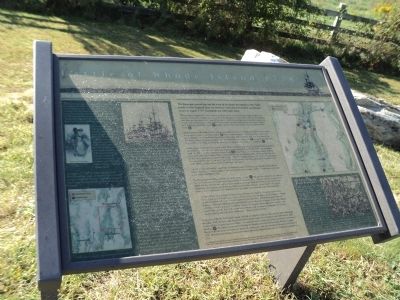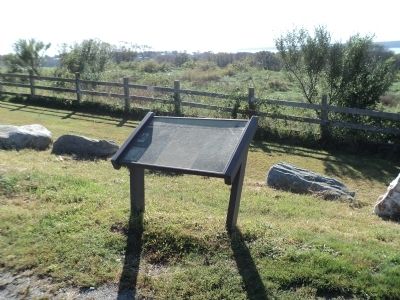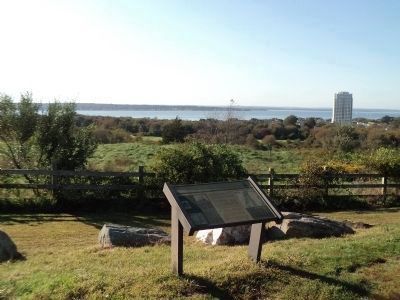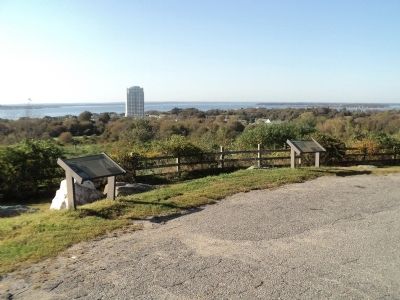Portsmouth in Newport County, Rhode Island — The American Northeast (New England)
Battle of Rhode Island 1778
During the American Revolution the British strategy focused on controlling American ports and blockading the coast. Because of Newport’s significance as a deep-water port and as a center of trade, British forces landed in Newport in December of 1776 to occupy the city and the outlying farms of Middletown and Portsmouth with a garrison of 6,100 British and German mercenary troops.
The Americans also understood Newport’s strategic significance and planned to recapture it. By mid 1778 the plans were in place for an American army under Major General John Sullivan to link with allied French forces under Admiral D’Estaing and march in concert to attack the Crown’s forces in Newport under the command of Major General Robert Pigot.
On August 8th, 1778, the French fleet entered Narragansett Bay where an American army of 10,000 troops crossed from Tiverton. The British withdrew their troops to a ring of forts and earthworks around Newport.
As the French and American forces readied for a march towards Newport on the 10th, the sails of the British fleet were spotted on the Narragansett Bay. The French began re-embarking and began making preparations to give chase despite Sullivan’s pleas to continue the land campaign.
< Text illegible at this point >
It was not until the morning of August 15th that the Americans were able to move south. They laid siege to Newport and began firing on the British positions on the morning of August 19th. On August 20th the French fleet returned only to tell Sullivan that the following morning they intended to sail to Boston.
Without the support of the French and with word from George Washington that British reinforcements were headed to Newport, Sullivan now saw the danger of his army being trapped on the island. Reluctantly, he began the slow process of withdrawing the army and all its baggage to the north where it would be evacuated to the mainland. At the same time, he kept up a steady cannonade on the British in Newport to mask the withdrawal.
The Battle of Rhode Island August 29, 1778
The landscape around you was the scene of the largest Revolutionary War battle fought in New England. Here an American army faced the British and Hessian troops in August 1778. Landmarks are still visible today.
On the night of August 28th, 1778, Sullivan withdrew the last of his troops from outside Newport and retreated northward to fortified positions on the hills of Portsmouth where they could hold off the British army while the Americans were ferried off the island. British General Pigot made immediate preparations to pursue the American forces. He detailed British regiments under Brigadier General Francis Smith to move north along East Main Road. (1) He gave the German troops the task of moving up West Main Road. (2)
Smith’s column on East Main Road soon ran into trouble when it was ambushed by an American picket at the corner of present day Union Street. (3) German reinforcements hurried along Union Street, and after regrouping, Smith pushed the Americans up East Main Road to Quaker Hill. On West Main Road, the Germans drove the Americans back to a fortified position on Turkey Hill. (4) As the British continued to press the attack, Sullivan ordered the American rear guard to retire north to the main line. (5)
As the Americans withdrew from Quaker Hill, Smith’s regiments charged up East Main Road and attacked the left flank of the American main line. Under the command of General John Glover, the Americans repulsed the enemy, who withdrew to Quaker Hill. (6) Meanwhile, the Hessians had advanced up West Main Road and occupied Almy Hill and Turkey Hill, facing the American right. It soon became clear that the key to the American position was on the right. Here, the heights that characterized the left and center ran out and to the west of Lehigh Hill lay relatively flat ground which extended along the shoreline to the north offering a clear route to the rear of the American lines.
The Americans had fortified Lehigh Hill
and manned a redoubt in front of the hill with the First Rhode Island Regiment, an infantry regiment that included slaves, free blacks, and Native Americans who fought in the cause of independence.
The Hessians launched three attacks against the American right. (7) The first two attacks were broken up and repulsed by musket volleys before they reached the American line. The third attack was more determined than the previous two, and nearly succeeded in carrying Lehigh Hill. However, the First Rhode Island held their position, and American reinforcements surged forward. Rhode Island’s own Major-General Nathaniel Greene had command of the right flank, and he described the action as follows:
A warm Cannonade commenced and lasted for several hours with continual skirmishes in front of both Lines. About two o’clock the Enemy began to advance in force upon our right as if they intended to dislodge us from the advanced Redoubt. I had the command of the Right Wing. After advancing four Regts and facing the enemy still gaining ground, I advanced with two more Regiments of regular Troops and a Brigade of Militia and at the same time Gen. Sullivan ordered Col. Livingston with the Light Troops under his command to advance. We soon saw the Enemy to the rout and I had the pleasure of seeing them run in more disorder than they did at the Battle of Monmouth. (Showman
1980: 501-502)
At the close of the Battle of Rhode Island, both sides occupied fortified positions on the hills overlooking the valley. With the knowledge that General Clinton was on his way to Newport with 5,000 more British troops, Sullivan realized that evacuation to the mainland was necessary and safely ferried his troops back to Tiverton. (8) The American attempt to dislodge the British forces had failed, and the British occupied Newport and the whole of Aquidneck Island for another year until they abandoned Newport in October of 1779. French forces afterward entered Newport and were stationed there until the Yorktown campaign in 1781.
The Rhode Island “Black Regiment”
In February 1778, to meet growing manpower needs, the Rhode Island General Assembly passed a act promising black recruits all the bounties, wages and encouragements received by other groups. The famous Black Regiment of Rhode Island was formed in the spring of 1778 to replace the members of the 1st Rhode Island Regiment who had died through the early campaigns of the Revolutionary War. Upon passing muster, slaves were to be immediately discharged from the service of their master or mistress and freed, as though never encumbered with either servitude or slavery. Free black men and Native Americans who volunteered served in the 1st Rhode Island Regiment, where they were segregated in companies serving with white officers. The regiment is significant as the first predominantly black regiment to fight in the American army. After fighting for five years, black veterans returned to Rhode Island at the end of the war to the enduring struggle for jobs, equality and the money due them for participating in the war.
Topics. This historical marker is listed in these topic lists: African Americans • War, US Revolutionary. A significant historical month for this entry is February 1778.
Location. 41° 36.677′ N, 71° 15.628′ W. Marker is in Portsmouth, Rhode Island, in Newport County. Marker is at the intersection of West Main Road (Rhode Island Route 114) and Anselmo Drive, on the right when traveling south on West Main Road. Marker is located in the Lehigh Hill Overlook. Touch for map. Marker is in this post office area: Portsmouth RI 02871, United States of America. Touch for directions.
Other nearby markers. At least 8 other markers are within 3 miles of this marker, measured as the crow flies. Garden of New England (here, next to this marker); Butts Hill Fort (approx. 0.6 miles away); The 1st Rhode Island Regiment and the Battle of Rhode Island (approx. 0.7 miles away); Site of the Battle of Rhode Island (approx. 0.7 miles away); The Black Regiment (approx. 0.7 miles away); Portsmouth Compact (approx. 1.3 miles away); W 3 R (approx. 1˝ miles away); Mount Hope Bridge (approx. 2.4 miles away). Touch for a list and map of all markers in Portsmouth.
More about this marker. Pictures of Major General John Sullivan and the French Fleet appear on the right of the marker, and the Black Regiment at the lower right. A map of Aquidneck Island showing the British defenses and the approach of the American Army and French Fleet is at the lower left. Another map on the right details troop movements during the Battle of Rhode Island.
Also see . . . The Battle of Rhode Island. (Submitted on October 16, 2011, by Bill Coughlin of Woodland Park, New Jersey.)
Credits. This page was last revised on June 16, 2016. It was originally submitted on October 15, 2011, by Bill Coughlin of Woodland Park, New Jersey. This page has been viewed 2,221 times since then and 20 times this year. Photos: 1, 2, 3, 4, 5. submitted on October 15, 2011, by Bill Coughlin of Woodland Park, New Jersey.




